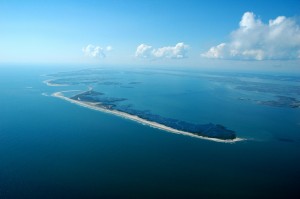In this seasonal three-part special, P.J Ryan – author at the excellent National Parks Traveler – treats us to an in depth look at the work of The Nature Conservancy – America’s leading conservation organization. Acclaimed for their work to protect ecologically important lands and waters, The Nature Conservancy has now protected more than 119 million acres of land and thousands of miles of rivers worldwide, including an array of private islands. P.J Ryan tells us more:
Forbidden Islands have always fascinated people.
Why? Well, I don’t know. Perhaps due to both their mystery and privacy. If you totally own an island, your only neighbor is, well, God.
That must give the owner a feeling of confidence and power. Can’t blame a person for wanting to own an island. It sort of contradicts John Donne’s famous line, “No man is an island.” You are one if you own one.
Private forbidden islands are pretty rare, particularly in America. The largest private island is Niihau, a 6-mile-by-18-mile in Hawaii owned by the Robinson family. Then there is Kahoolawe Island, a 6-mile-by-11-mile Hawaiian cultural reserve that is off limits to non-native Hawaiians, except for work crews.
Smack dab in the jaws of Long Island’s Peconic Bay lies the very secret 435-acre Robin’s Island, purchased as a hunting preserve for $11 million in 1997 by the billionaire financier Louis Bacon. He does not feel the need for your company.
At the ocean end of Long Island is the even more mysterious 6-mile-by-3-mile, 3,300-acre Gardiner’s Island, owned by the Gardiner family for nearly 400 years. The Gardiners had uncanny skill at marrying money (Julia Gardiner married President John Tyler) so they could afford to be reclusive. Gardiner’s Island is renowned for the largest stand of old growth White oak left in North America and the site where Captain Kidd buried his treasure. (Yes, he really did! It was later dug up and used as evidence against him in his trial.)
Between the Massachusetts mainland and Martha’s Vineyard lie the Elizabeth Islands. This archipelago is the domain of the extended Forbes family, who are richer than God. (One of the extended family members is Senator John Kerry; a frequent visitor to the Elizabeths.) Still, the Forbes are not to be entirely envied; several of the islands are overrun with poison ivy and deer ticks carrying Lyme disease.
The Georgia Sea Islands with their pleasant winter climate lent themselves to baronial private ownership, as in the case of 16,500-acre Sapelo Island (The RJ Reynolds family) and 36,000-acre Cumberland Island (The Carnegie family).
Private islands are expensive to keep up, so Sapelo Island is now a biological research area owned by the University of Georgia, while Cumberland Island is now a unit of the National Park Service (Cumberland Island National Seashore). Interestingly enough, Cumberland Island National Seashore is one of the very few restricted natural area units of the NPS; requiring advance reservation for admittance. This may be a harbinger of the future, for sensitive areas such as Yosemite Valley.
This article originally appeared in the National Parks Traveler on October 17th 2012. Many thanks to the author, PJ Ryan, and the rest of the team at National Parks Traveler for their assistance.



